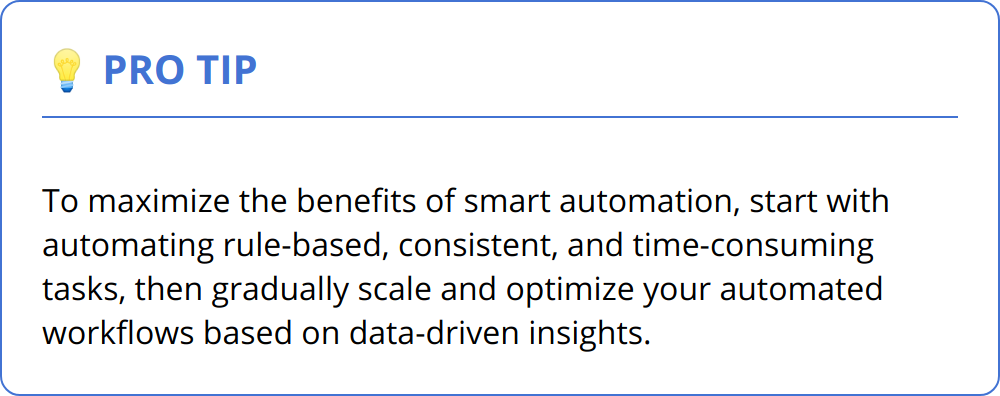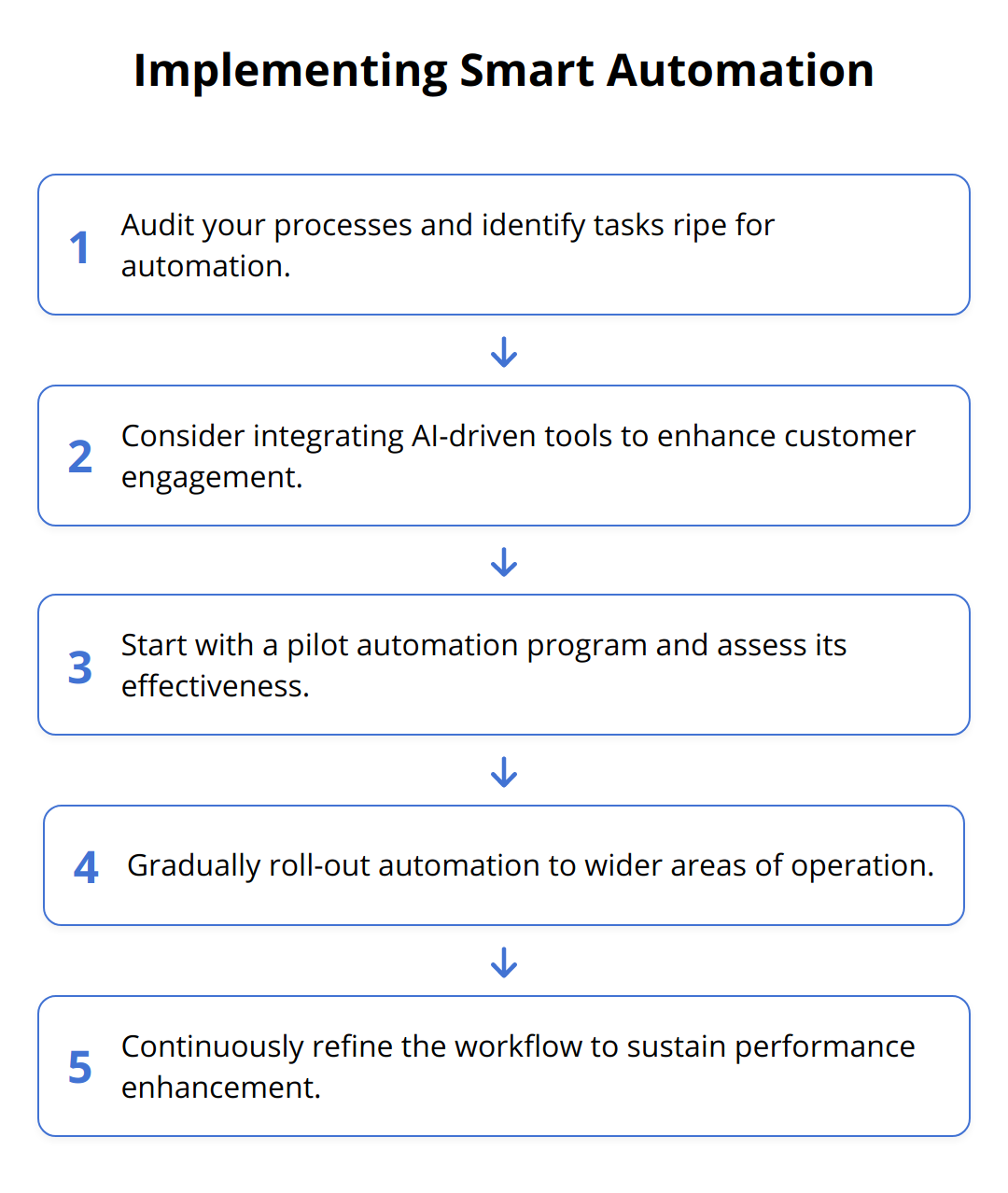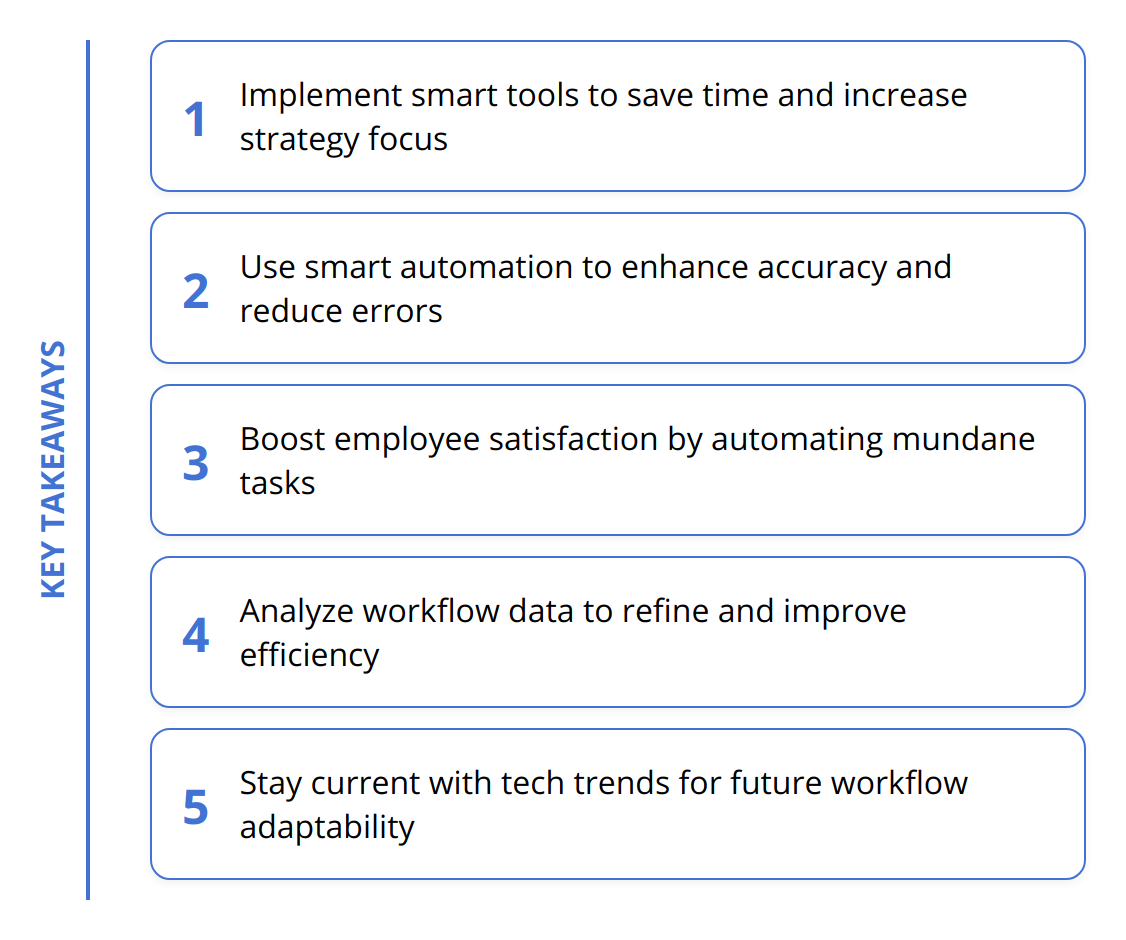We at Emplibot understand the significant impact that smart automation workflows have on modern businesses. Streamlining operations not only boosts efficiency but also has a tangible effect on overall performance.
Organizations that leverage these powerful tools can transform how they work, from simplifying mundane tasks to reshaping their business models for the future. Join us as we explore the world of smart automation and its profound influence on the business landscape.
What Is Smart Automation?
Smart automation, a game-changer in the world of business, refers to systems that use artificial intelligence (AI) and machine learning to enhance workflow automation. These systems bring a new level of intelligence to standard automation by learning from and adapting to data, patterns, and results over time. Unlike traditional automation which follows predefined rules, smart automation can make complex decisions and improve processes autonomously.
Here are some key components of smart automation workflows:
-
Data Analytics: At the heart of smart automation is data analytics, integral for understanding patterns, predicting outcomes, and making informed decisions.
-
Machine Learning: These workflows utilize algorithms to learn from data, identifying opportunities for optimization without explicit programming.
-
Integration Capabilities: The ability to seamlessly integrate with other tools ensures that smart automation workflows can adapt to a variety of tasks across systems.
Businesses adopting smart workflow solutions witness a stark difference from traditional automation. Here’s what sets smart automation apart:
-
Adaptive Learning: Unlike traditional systems that require manual updates to rules, smart automation workflows learn and evolve, staying ahead of changes in business processes.
-
Predictive Action: These systems don’t just follow commands; they predict the best course of action based on historical data.
-
Complex Decision Making: Smart workflows handle multifaceted scenarios that traditional automation simply cannot manage due to its rigid programming.

For anyone considering enhancing their operations with smart automation, it’s wise to start with a few practical integration tips:
- Identify which processes would benefit most from smart automation, such as customer service ticketing or lead scoring in sales.
- Use analytics tools to gather data for your smart workflows to learn from.
- Begin with one workflow to measure the system’s impact before implementing it across your organization.
Efficiency gains are undeniable with smart workflows, which automate complex tasks and free up valuable human resources to focus on strategic work. By adopting smart automation, companies position themselves at the forefront of innovation, harnessing the power of AI to not only boost productivity but also reimagine what’s possible in their industry.
Streamlining with Smart Automation
Transitioning from traditional operations to smarter, automated workflows is not just about technology—it’s about rethinking how every task fits into your company’s ecosystem. Mapping out tasks that are essential but repetitive positions your business to make a leap in productivity. The key lies in identifying the right tasks for automation and then using sophisticated software to integrate these changes effectively.
When considering which tasks to automate, start with those that are rule-based, require consistency, and are time-consuming. For instance, customer inquiry responses, inventory updates, and basic data entry are prime candidates. These tasks, when handled manually, can bog down your staff and lead to errors, but when automated, they become swift and error-free.
Implementing smart automation requires the right tools. Software solutions like Shopify Flow excel in creating automated workflows that take the heavy lifting off your team’s shoulders. Imagine combining same-day orders automatically, or triggering personalized customer loyalty programs based on purchase history—this is the power at your fingertips with such platforms.

To ensure you’re getting the most out of smart automation, adhere to best practices for streamlining your operations:
-
Assessment: Examine your current processes thoroughly. Understand where your bottlenecks are and which tasks can be automated for maximum impact.
-
Strategic Implementation: Start small with automation to gauge its effectiveness. Often one well-implemented workflow can be more valuable than several poorly executed ones.
-
Data-Driven Decisions: Use data to inform your automation strategy. By analyzing outcomes, you can refine and adjust workflows to better serve your business needs.
-
Continuous Improvement: Encourage a culture of ongoing optimization. As your workflows become more sophisticated, look for new opportunities to automate and enhance efficiency.

Remember, adopting smart automation is just the beginning. Keeping an eye on trends—like the increasing role of AI in customer interactions or the integration of IoT devices—can give you a competitive edge. By remaining vigilant and adaptive, your business is not just streamlining current operations but also paving the way for future innovations.
How Does Smart Automation Enhance Performance?
The introduction of smart automation into business operations has proven to be a game-changer. Firms that successfully utilize these tools often notice a substantial improvement in efficiency and accuracy. Perhaps the most direct benefit businesses realize is significant time savings. Automation handles routine tasks with unparalleled speed, allowing human employees to turn their attention to more complex projects that require creative thinking and strategic planning.
For example, a case study from a leading e-commerce platform showed that companies employing smart automation for their inventory management reduced time spent on restocking by 50%. This is a compelling illustration of how automation can create more space for value-added activities.
Another quantifiable benefit is the reduction of errors. Human error is an unavoidable part of manual processes but becomes a non-issue when smart automation takes the reins. Implementing these systems for tasks like data entry can virtually eliminate inaccuracies, saving costs related to rectifying mistakes. Real-life evidence from financial institutions reveals that introducing automation in transaction processing cut down error rates by roughly 70%.

Besides efficiency and accuracy, businesses that integrate smart automation often report enhanced employee satisfaction. This can be attributed to the elimination of repetitive and mundane tasks, which can be a significant source of job dissatisfaction. When employees are freed from these tasks, they report higher job engagement and satisfaction, leading to reduced turnover rates. Insights from the service industry indicate that automating customer service tasks can improve employee morale, as staff can focus on more engaging customer interactions, thereby enhancing the quality of service.
So, how can your business start seeing similar results? Here are some practical steps:

Importantly, businesses that stay abreast of emerging technologies and continually refine their workflows are more likely to sustain these performance enhancements over time. Upcoming trends such as the integration of IoT, for example, promise to offer new avenues for automation of tasks and further productivity gains.
Finally, remember that the impact of smart automation is not just internal. By delivering faster services with fewer errors, companies that harness these tools often see an uptick in customer satisfaction and loyalty – a definite edge in today’s highly competitive market.
In summary, whether it’s through freeing up employee time, reducing costly errors, or improving job satisfaction, smart automation workflows are a powerful lever to pull in the pursuit of enhanced business performance. With the right approach to integration and ongoing refinement, these systems offer a clear path to operational excellence.
Shaping Tomorrow’s Business with Automation
The landscape of business is changing at an impressive pace, and smart automation is at the forefront of this transformation. As artificial intelligence (AI) and machine learning continue to evolve, they pave the way for more sophisticated automation technologies that redefine what businesses can achieve.
Embracing AI and Machine Learning
AI and machine learning are revolutionizing how businesses operate. With the ability to not only process vast amounts of data but also learn and predict outcomes, these technologies are making automation smarter than ever before. For instance, companies using AI to analyze customer data can anticipate needs and tailor services accordingly, leading to increased customer satisfaction and retention.
Moving forward, leaders should keep a close eye on advancements within AI, such as natural language processing (NLP) and computer vision. These technologies can interpret human language and visual information, opening new doors for automation in areas like customer service and quality control.
Adapting to Remote and Hybrid Work Models With Automation
The surge in remote and hybrid work models is another area where automation is playing a key role. Automation tools facilitate seamless collaboration regardless of geographic location, ensuring that remote teams stay synchronized and productive. These tools range from project management software to automated scheduling systems and virtual assistants.
Organizations aiming to succeed in remote or hybrid environments must prioritize selecting automation tools that enhance workflow transparency and communication. Cloud-based platforms are particularly effective, allowing employees to access the necessary information and tools from anywhere.
Preparing for the Next Wave of Automation Technology
To stay competitive, businesses must equip themselves for the newest developments in automation technology. This means investing in training and upskilling programs for staff to handle advanced systems and focusing on scalability when choosing automation solutions.
As we look to the future, three key areas should be top of mind for every business:
-
Integration of IoT: The Internet of Things (IoT) promises to introduce automation in more tangible, everyday tasks – from inventory tracking to energy management. Ensuring your systems are compatible with IoT devices will soon be a standard business requirement.
-
Hyper-automation: Going beyond basic task automation, hyper-automation combines AI, machine learning, and advanced analytics to automate complex business processes. It’s worth considering how hyper-automation could enhance your business operations.
-
AI-driven Customer Experiences: Personalized customer experiences are no longer a luxury but a necessity. With AI, businesses can automate personalized marketing campaigns with precision, driving engagement and loyalty.
Here’s how to prepare for these advancements:
-
Invest in training resources to help your team stay current with the latest in automation technology.
-
Choose scalable automation platforms that grow with your business needs.
-
Optimize data collection and analytics to feed into your AI and machine learning algorithms, allowing for continuous improvement of automated tasks.
Foresight and adaptability are essential as businesses navigate through the evolving world of automation.
Keep pushing for innovation within your automated workflows, and be ready to harness new technologies as they emerge. By doing so, the efficiency, capabilities, and growth potential of your business will continue to reach new heights.
Final Thoughts
The journey through smart automation workflows has illustrated that these tools are not just a mere upgrade to existing systems, but a transformative force reshaping business operations. Streamlining with smart automation goes beyond efficiency—it’s about elevation. By automating mundane tasks, companies unlock the potential for growth, innovation, and staying power in a rapidly evolving marketplace.

In the vast ocean of operational tactics, smart workflows are the lighthouse guiding businesses to safe harbors of efficiency and competitive advantage. The beauty of automation lies in its capacity to adapt, learn, and improve over time, making it an invaluable ally for any size business seeking to flourish in today’s climate.
Key takeaways for businesses looking to streamline operations:
-
Time-saving magic of automation clears the way for strategic endeavors
-
Accuracy and reliability enhancements minimize errors and bolster trust
-
Employee satisfaction boost as teams engage in more meaningful work
-
Scalability and adaptability for a future-proofed operation
To fully harness the transformative benefits of automation:
-
Identify areas in your business primed for smart workflow automation
-
Implement smart tools strategically, starting small and scaling with success
-
Analyse and adjust your workflows based on real-world data and feedback
-
Prepare for the future by adapting to new technologies and trends
We at Emplibot recognize the unparalleled opportunities presented by smart automation workflows. Our software is engineered to bring the benefits of automation directly to your fingertips. By automatically publishing SEO-friendly articles, conducting keyword research, and ensuring your WordPress site remains dynamic and engaging, we help businesses maintain a robust online presence with zero manual effort.
By streamlining content creation and curation processes, organizations can allocate more resources towards other business-critical operations. Imagine the empowerment of knowing your blog is growing and contributing to your SEO strategy while your team focuses on innovation and customer relationships.
In essence, smart automation is a steadfast partner in your journey to operational excellence. Companies that embrace automation not only set themselves apart but also craft a future where staying ahead of the competition becomes a byproduct of their operational model.
We invite you to embrace the transformative benefits of smart workflows, and in doing so, reimagine the potential of your business. Dive into the world of automation, and discover firsthand how tools like Emplibot can multiply your efficiency and effectiveness.
As the progressive tides of technology continue to swell, there’s no better time than now to align your sails with the winds of smart automation. Set your coordinates for success, and watch your business thrive in the streamline revolution that lies ahead.

